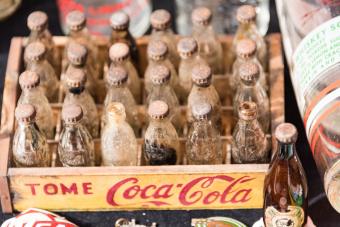
Collecting antique bottles is a fun and interesting hobby, but anyone who has picked up one of these old bottles knows how easy it is to get confused when trying to decipher the markings on the glass. The things is, these markings are the key to telling a fake from a find and to determining the age and value of your bottle.
Don't worry, though. Once you know what to look for, you'll be able to spot a great bottle during your next visit to the flea market or antique shop.
How to Identify Antique Bottle Markings
Although many factors, including condition, rarity, and age, contribute to the value of an antique bottle, the markings on the bottom or side of the glass can tell you quite a bit about a bottle's history and what it's worth. Follow these simple steps for identification of valuable old glass bottle markings.
1. Find the Markings

To find the markings, examine the bottle carefully. The side of the bottle may be printed with the product or manufacturer's name, and this can help identify your find.
Also turn the bottle over. Many bottles have marks on the bottom, and these are important signatures of bottle manufacturers. If the mark isn't obvious on the bottom of the bottle, feel for it with your finger.
If you're unable to read a mark by looking at it, try placing a piece of white paper on the bottle and lightly rubbing over the mark with a piece of charcoal or a crayon.
2. Identify the Type of Markings
After you've found the mark on the bottle, classify it by type. Bottles made in the U.S.A. have markings that fall into a few categories:
- Embossed marks - Embossed labels or product names often appear on the sides of bottles. These can include words like "cough syrup" or a manufacturer's name.

- Maker's marks - Maker's marks often appear on the bottom of the bottle. These take the form of numbers, letters, symbols, or names.

- Pontil marks - Pontil marks are circular shapes on the bottom of the bottle that indicate that the bottle is made of free-blown glass. This mark occurs when the pontil or blowing tube is broken off the bottom of the bottle.

- Mold lines - Mold lines and machine marks appear on many antique bottles that were made during the late 19th and early 20th centuries. These often look like narrow lines or small circles on the base of the bottle.

3. Examine Photos and Pricing Guides
Once you've found the marks, it's time to figure out what they mean. The internet is an excellent resource for identifying the markings on antique bottles. The following websites can help you determine the manufacturer and age of your bottle based on the markings:
- AntiqueBottles.com has a ton of information about pricing and collecting antique glass, including a page of photos of various types of pontil marks and manufacturer marks on the bottoms of bottles.
- Glass Bottle Marks is a great resource if you want to identify the manufacturer of a bottle since they have an alphabetical list of manufacturers and their marks.
- More Bottle Marks is a table of common manufacturer's markings on the bottoms of antique bottles.
- The Bureau of Land Management and the Society for Historical Archaeology maintain a very helpful site for identifying bottles based on their markings. This site includes some great photos.
4. Understand How Marks Affect Value
The markings on the bottle can directly affect its value. Some markings demonstrate how the bottle was manufactured, and this can be a clue about its age. For example, pontil marks typically indicate an older bottle, which is sometimes more valuable. Some pontil bottles can sell for hundreds or even thousands of dollars.
Scarcity is a major factor in antique bottle values, and collectors covet certain valuable old glass bottle markings. For instance, according to Antique Bottle Trader, an amber glass blackberry brandy bottle with a star mark on it from the Pacific Glass Works was valued at about $2,200 because only 15 of these bottles exist.
Don't worry if you don't know off the top of your head how to figure out the value of your bottle from the marks. Once you know the marks, you can research them. Look up the manufacturer, for example, to find out which of their bottles are the rarest.
Is It Really Antique?
Understanding bottle markings can also help you spot a fake. While a pontil or a manufacturer mark might not help too much, it's the date you want to watch for. Any bottle that's stamped with a super old date deserves a bit of scrutiny. According to Historic Glasshouse, modern reproductions typically feature marks that include a date from before 1850.
If you want to dig a little further into whether the marks indicate a potential fake, it's all about combining the info you have. Say your bottle was stamped with the year 1835. Check to see if it has mold lines. If it does, it's probably a reproduction because mold lines are more commonly found on bottles from the late 19th century and onward.
Antique Bottle Marks Are Clues
The more you know about antique bottle markings, the better you'll be at finding a valuable and exciting antique bottle for your collection and spotting potential fakes. It's also handy for selling a bottle and getting the best price since potential buyers will want to know everything they can about the bottle. So grab your magnifying glass and give that bottle a good look. You'll find plenty of clues about its history right there.






